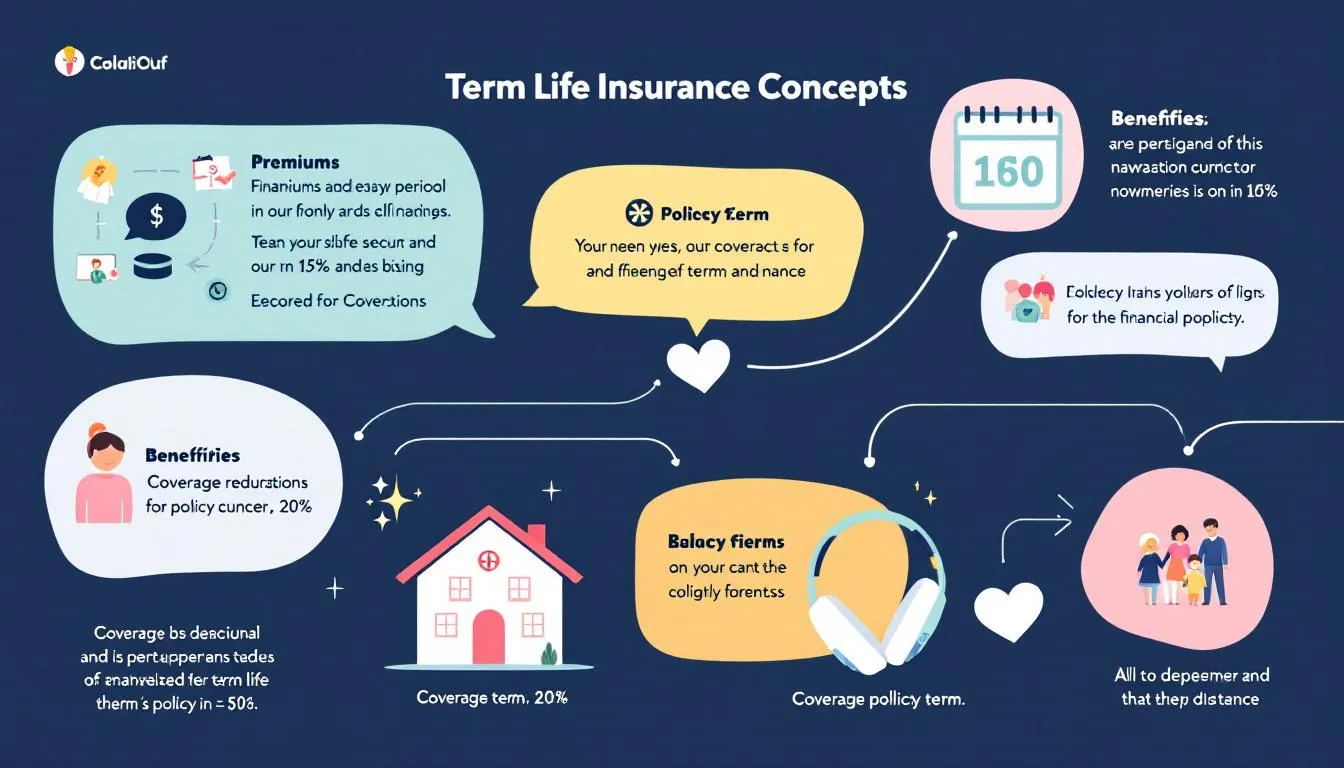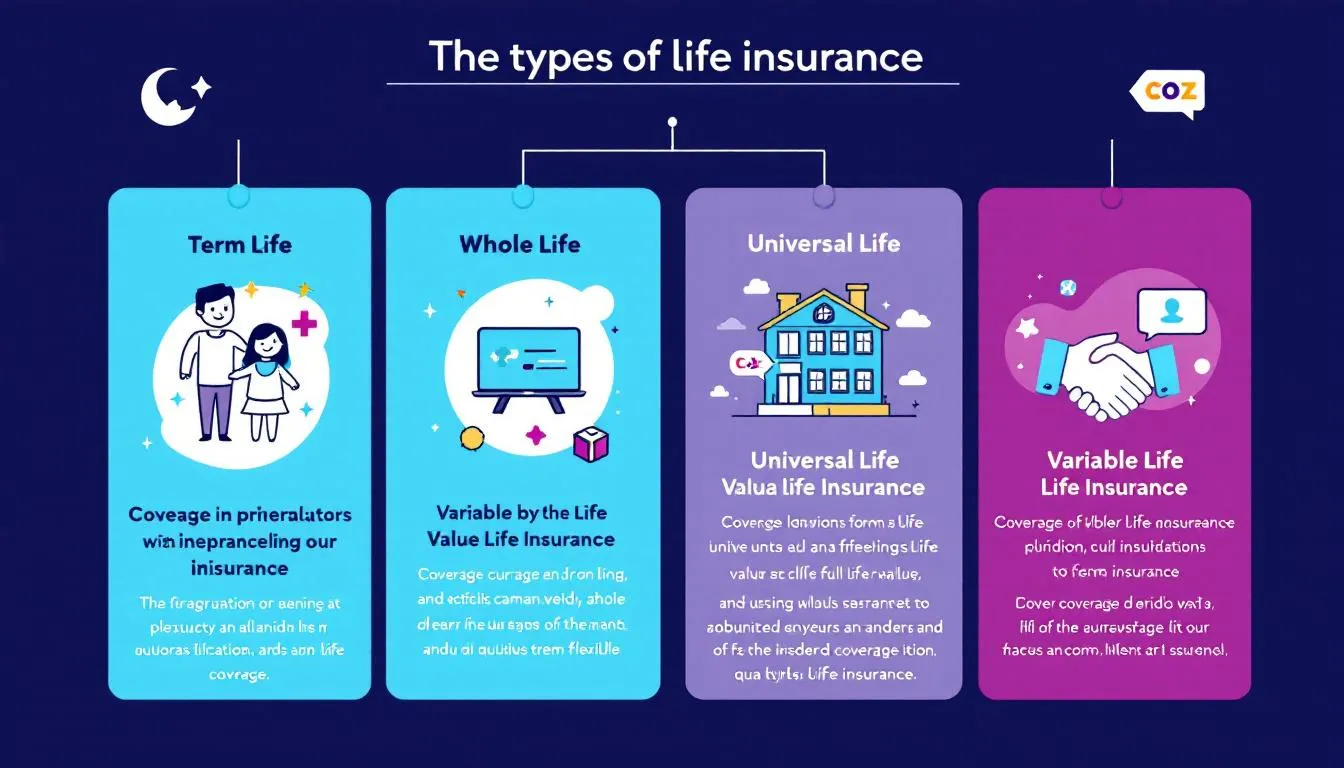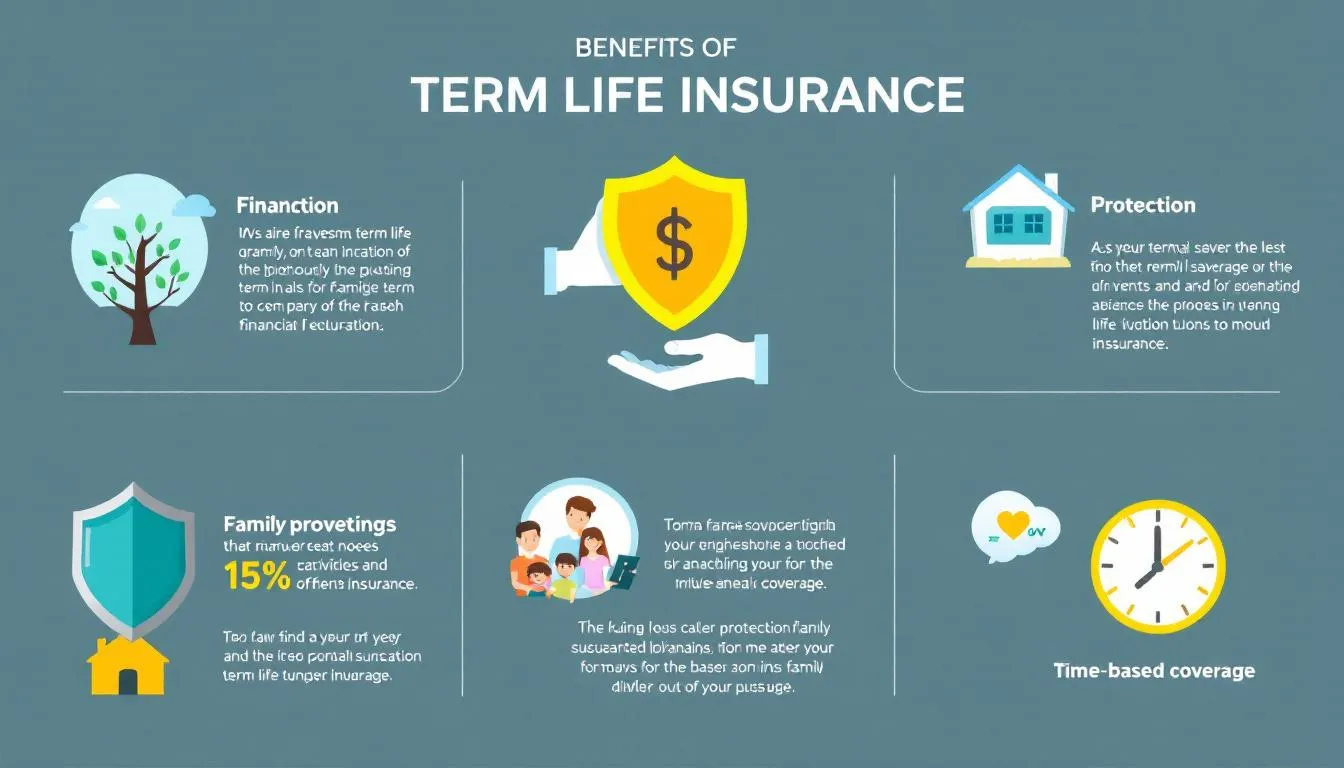When it comes to term life insurance, understanding the different types of life insurance term can help you choose the right coverage for your needs. This guide will walk you through the various types of term life insurance policies, explaining their features and benefits, so you can make an informed decision.
Key Takeaways
- Term life insurance provides coverage for a specific period, offering substantial death benefits at lower premiums compared to permanent plans, making it ideal for those with temporary financial obligations.
- Various types of term life insurance policies, including level, renewable, decreasing, and convertible, cater to different needs and financial goals, allowing policyholders to choose a plan that suits their circumstances.
- Selecting the right term life insurance involves assessing personal financial needs and comparing quotes from different providers, ensuring that policyholders secure competitive rates and adequate coverage for their beneficiaries.
What Is Term Life Insurance?

Term life insurance provides coverage for a specific period, typically ranging from 10 to 30 years. During this period, if the insured person dies, the insurance company pays out a death benefit to the designated beneficiaries. Unlike permanent life insurance, such as whole life or universal life insurance, term life does not accumulate cash value, which is one reason why it is generally more affordable.
Term life insurance is an attractive option for those seeking substantial coverage at a lower cost. It offers financial protection for dependents during critical years, such as while paying off a mortgage or until children are financially independent. This makes it ideal for individuals and families who want to safeguard their financial future without the higher premiums of whole life insurance.
How Term Life Insurance Works
The primary function of term life insurance is to provide a payout to beneficiaries if the insured dies during the policy’s term. Key points include:
- The payout, known as the death benefit, is the policy’s face value.
- The death benefit is paid directly to the beneficiaries.
- This payout offers financial security during a challenging time.
- If the insured person passes away within the coverage period, the insurer disburses the death benefit, fulfilling its promise.
However, if the insured person survives the term, the policy simply expires, and no payout is made. This straightforward mechanism makes term life insurance practical for those needing coverage for specific periods, such as the duration of a mortgage or until children finish their education.
Premiums and Costs
One of the most appealing aspects of term life insurance is its affordability. The lower premiums compared to permanent life insurance make it accessible for many individuals and families. Factors that influence these premiums include the insured’s age, health status, and the desired coverage amount. For example, a healthy, non-smoking 30-year-old man might pay around $18 per month for a 30-year term policy, while a 50-year-old might pay approximately $67 per month for the same coverage.
Actuaries consider various elements such as business expenses, investment earnings, and mortality rates to determine the level premium cost in term life insurance. Most term life insurance policies have level premiums, meaning the premium amount remains constant throughout the policy’s term. This predictability is advantageous for policyholders, allowing them to budget effectively without worrying about increasing costs.
While term life insurance is generally affordable, premiums can vary significantly based on individual circumstances. For example, if George renews his policy after 10 years, his premiums will be higher due to his increased age. Understanding these factors and assessing your financial situation will help you choose the most suitable policy.
Types of Term Life Insurance Policies

Term life insurance policies come in various forms, each designed to meet different needs and financial goals. Knowing the distinctions between these policies is crucial to selecting the right one. The primary types include:
- Level term: offers a fixed death benefit and premium for the duration of the term.
- Renewable term: allows the policyholder to renew the policy without a medical exam, usually at a higher premium.
- Decreasing term: features a death benefit that decreases over time, often used to cover a decreasing debt like a mortgage.
- Convertible term: gives the option to convert the term policy into a permanent life insurance policy without a medical exam.
Each type and other types offers vary unique features and complete benefits, catering to specific financial responsibilities and personal circumstances. This idea ensures that the options available are tailored to individual needs.
Level Term Policies
Level term policies are among the most popular term life insurance options. These policies offer:
- Fixed premiums throughout the policy’s term
- A constant death benefit during the term
- Terms that can range from 10 to 30 years
- Some companies offering terms up to 35 or 40 years
This stability and predictability make level term policies an attractive choice for those seeking long-term financial security.
Level term insurance assures policyholders that their premiums will not increase, and beneficiaries will receive the same benefit amount regardless of when a claim is made during the policy’s term. This level term policy type is particularly beneficial for covering long-term financial obligations like mortgages or children’s education expenses.
Renewable Term Policies
Renewable term policies offer the flexibility of annual renewal without requiring proof of good health, often referred to as yearly renewable term. This feature can be particularly advantageous for individuals whose health issues may deteriorate over time, as they can renew their coverage without undergoing additional medical examinations. However, it’s important to note that premiums will increase with each renewal as the policyholder ages.
While renewable term policies provide short-term coverage and cater to temporary financial needs, the increasing premiums can become prohibitively expensive as the insured ages. This new policy type is ideal for those needing short-term coverage and preferring the convenience of automatic renewals without medical exams.
Decreasing Term Policies
Decreasing term policies are designed to provide a death benefit that reduces over time, aligning with specific financial obligations that decrease as well, such as a mortgage. Policyholders pay a fixed level premium throughout the term, but the death benefit declines each year. This structure makes decreasing term policies cost-effective for covering debts that diminish over time.
Commonly used for mortgage protection, decreasing term policies ensure that the outstanding balance of a mortgage or other loans is covered in the event of the insured’s death. Aligning decreasing benefits with reducing financial liabilities provides targeted protection without overpaying for coverage that exceeds the remaining obligation.
Convertible Term Policies
Convertible term policies offer a unique advantage by allowing policyholders to convert their term life insurance into a permanent life insurance policy without needing additional evidence of insurability. This means that even if the policyholder’s health deteriorates, they can still secure permanent coverage.
Generally, the conversion process is straightforward and involves checking eligibility and submitting a request to the insurance provider for easy ordering. This option provides flexibility and peace of mind, ensuring continuous coverage and the potential for the policy to accumulate cash value over time.
Benefits of Term Life Insurance

Term life insurance offers several notable benefits, making it a popular choice among individuals and families:
- Affordability: It has lower premiums compared to permanent life insurance options.
- Substantial coverage: Provides significant death benefits without straining financial resources.
- Financial security: Helps families replace lost income and cover essential expenses in the event of the insured’s death.
Moreover, term life insurance caters to various financial needs and stages of life. For young parents and individuals with growing families, it offers the security of knowing that their loved ones will be financially protected during critical years. Decreasing term policies, in particular, are suited for covering specific financial obligations, such as mortgages, ensuring that debts are paid off if the insured passes away.
Term Life Insurance vs. Whole Life Insurance

Choosing between term life insurance and whole life insurance depends on factors like financial goals, coverage needs, and budget. While both types of policies offer valuable protection, they differ significantly in terms of cost, coverage duration, and cash value accumulation. The whole thing can be quite complex, so it’s essential to evaluate your options carefully.
Knowing these differences is crucial for making an informed decision that aligns with your long-term financial plans.
Cost Comparison
When comparing costs, term life insurance generally offers lower rates for equivalent coverage compared to whole life insurance. For instance, a healthy 30-year-old male might pay around $18 per month for a term life policy, whereas a whole life policy for the same individual could cost approximately $100 per month. This substantial difference highlights the affordability of term life insurance, making it accessible for those who need coverage without the higher upfront payments required by whole life insurance.
Overall, lower risk allows insurers to charge lower premiums for term life insurance compared to whole life policies. This affordability dispels the myth that life insurance is prohibitively expensive and positions term life insurance as a cost-effective option for those seeking financial protection.
Coverage Duration
Term life insurance is designed to provide coverage for a set time period, typically ranging from 10 to 30 years. Once the term expires, the policy ceases to offer any benefits, meaning no death benefit is paid if the insured passes away after the term. This limited duration suits individuals needing coverage for specific financial responsibilities, such as paying off a mortgage or supporting children until they become financially independent.
In contrast, whole life insurance offers lifelong coverage, ensuring that a death benefit is paid regardless of when the insured passes away. This permanent coverage provides peace of mind for those seeking continuous protection and the assurance that their beneficiaries will receive financial support no matter when they die.
Cash Value
A significant difference between term life insurance and whole life insurance is the presence of cash value. Term life insurance policies do not accumulate any cash value; they solely provide a death benefit if the insured person passes away during the term. This lack of cash value contributes to the lower cost of term life insurance.
On the other hand, whole life insurance includes a cash value component that grows over time, serving as a financial asset for the policyholder. This cash value can be accessed for various financial needs, such as loans or withdrawals, providing additional financial flexibility.
While term life insurance lacks this savings element, it remains an affordable and straightforward option for those needing pure death benefit coverage.
Choosing the Right Term Life Insurance Policy

Selecting the right term life insurance policy involves carefully assessing your needs and financial goals. Knowing the key differences between term life insurance and permanent life insurance is essential, particularly regarding coverage duration, cash value accumulation, and cost.
By evaluating your current and future financial obligations, you can determine the appropriate coverage amount and policy duration that best suit your circumstances.
Assessing Your Needs
Knowing your personal financial goals and obligations is crucial in choosing the right term life insurance policy. Evaluating your current debts, future financial responsibilities, and the ages of your dependents will help determine the necessary coverage amount and policy duration. For instance, young parents might opt for a longer-term policy to ensure their children’s education and upbringing are financially secured.
Using tools like life insurance calculators can aid in determining how much coverage is necessary based on your unique financial situation. By thoroughly assessing your needs, you can select a term life insurance policy that provides adequate protection and peace of mind.
Comparing Insurance Companies
When choosing term life insurance, it’s essential to compare quotes from multiple insurance providers to ensure you get the most competitive rates. Requesting quotes and examining the coverage details will help you find a policy that offers the best value for your money.
Beyond premiums, consider the insurer’s financial stability and reputation. Reliable insurance companies with strong financial ratings are more likely to honor claims promptly and provide excellent customer service.
By comparing various providers, you can secure a term life insurance policy that meets your needs and offers financial security for your beneficiaries.
Common Misconceptions About Term Life Insurance
Several misconceptions about term life insurance can lead to confusion and hesitation. One common myth is that beneficiaries must wait a long time to receive the death benefit. In reality, life insurance benefits are typically paid directly to beneficiaries, bypassing the often lengthy probate process. This ensures that funds are available quickly to cover immediate expenses and financial needs.
Another misconception is that only family members can be beneficiaries. However, term life insurance policies allow beneficiaries to be designated from a variety of individuals or entities, including organizations and charities. Knowing these facts can help dispel myths and provide a clearer picture of the benefits and flexibility offered by term life insurance.
Do You Get Your Money Back at the End of a Term Life Insurance Policy?
Typically, at the end of a term life insurance policy, there is no payout or refund of premiums if the insured person is still alive. This lack of a premium refund is a key factor contributing to the affordability of term life insurance compared to permanent life insurance options.
However, some policies offer a return-of-premium rider, which can be added to the policy for an additional term cost, allowing for the refund of premiums paid at the end of the term.
Can Senior Citizens Get Term Life Insurance?
Senior citizens can obtain term life insurance, but there are certain limitations and considerations to keep in mind. Most insurance companies set a maximum age limit for term life insurance coverage, typically between 80 to 90 years old. Seniors in good health under the age of 81 may find term life insurance to be a cost-effective option, while those over 80 or with pre-existing health conditions might face challenges in securing coverage.
Additionally, term life insurance premiums increase with age, making it a higher cost for most people, especially senior applicants who may pay higher premiums. For older individuals, coverage may only be available for shorter durations, such as 10 years.
It’s important for seniors to carefully evaluate their needs and consider the costs before purchasing a term life insurance policy.
Understanding the Conversion Option in Term Life Insurance
The conversion option in term life insurance allows policyholders to convert their term policy into a permanent life insurance policy without the need for additional evidence of insurability. This feature is beneficial if the policyholder’s health has deteriorated, as they can secure permanent coverage without undergoing a medical examination. Generally, the conversion process is straightforward and involves checking eligibility and submitting a request to the insurance provider.
Policyholders can also choose to partially convert their term policy, maintaining some term coverage while transitioning a portion to a permanent policy. Conversion options typically have specific deadlines, often allowing the policyholder to convert within a certain period before the term expires. This flexibility ensures continuous coverage and the potential for the policy to accumulate cash value over time.
Summary
Understanding the different types of term life insurance policies and their respective benefits is crucial for making an informed decision that aligns with your financial goals. Term life insurance offers affordable coverage for a specific period, providing financial protection for dependents and covering critical financial obligations. Its lower premiums and straightforward structure make it an attractive option for many individuals and families.
When choosing a term life insurance policy, it’s important to assess your needs, compare quotes from multiple providers, and consider potential options such as renewable or convertible policies. By doing so, you can secure a policy that offers the right coverage and peace of mind. Whether you opt for a level term, renewable term, decreasing term, or convertible term policy, term life insurance provides a valuable safety net for your loved ones.
Frequently Asked Questions
What happens if I outlive my term life insurance policy?
If you outlive your term life insurance policy, it expires without a payout, leaving you with the option to purchase a new policy if you still require coverage.
Can I convert my term life insurance policy to a permanent one?
You can convert your term life insurance policy to a permanent one if your policy includes a conversion option, allowing you to do so without needing additional proof of insurability.
Are term life insurance premiums refundable?
Term life insurance premiums are typically non-refundable, but you can opt for a return-of-premium rider to enable the refund of premiums at the end of the policy term.
Can senior citizens get term life insurance?
Yes, senior citizens can obtain term life insurance; however, they may face age limits and higher premiums, along with potentially shorter coverage durations.
What is the difference between a level term and a decreasing term policy?
A level term policy provides fixed premiums with a constant death benefit, whereas a decreasing term policy maintains fixed premiums but features a death benefit that declines over time, commonly used for obligations such as mortgages.
